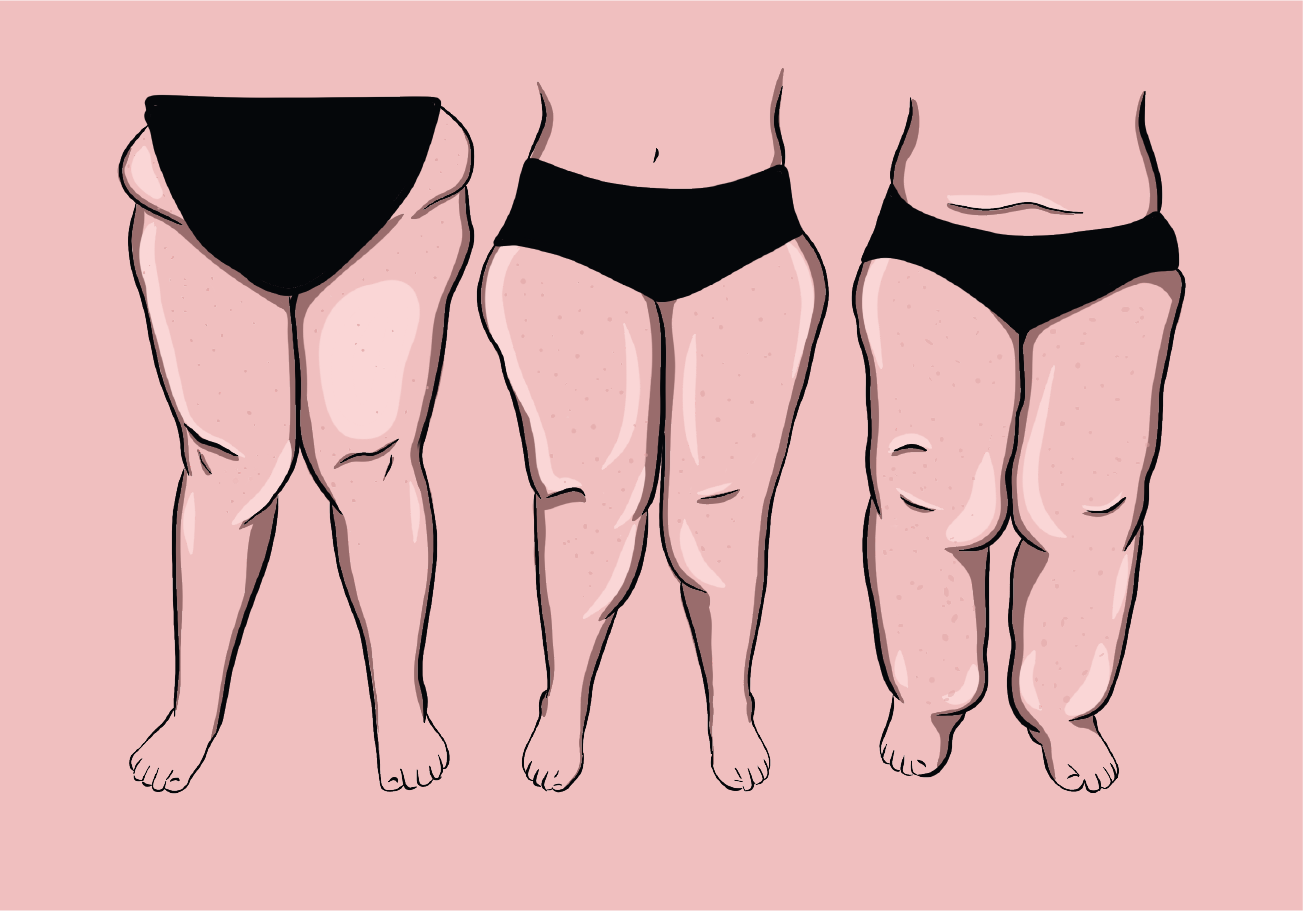
Let’s talk about it
Lipedema is a chronic medical condition that forms a symmetrical buildup of adipose tissue (fat) in the legs, arms, and lower trunk. It often causes pain, swelling, heaviness, loose skin, easy bruising, and the feeling of nodules under the skin. These nodules often feel like rice, pearls, or walnuts under the skin.
Lipedema affects almost exclusively individuals assigned female at birth (AFAB). Lipedema bodies come in various shapes and sizes. Lipedema can cause pain and disablement at any size.
Typically around puberty, but it can also develop or become more pronounced during other hormonal changes, such as pregnancy or menopause. Hormonal birth control may also be a trigger for the onset of lipedema symptoms.
Estimates suggest that up to 11% of females worldwide may have the condition. While the exact cause is unknown, genetics is believed to play a role, as it often runs in families.
Lipedema fat is often painful. People with lipedema report pain with massage, children or pets walking across their laps, or having their blood pressure taken.
Lipedema fat is often resistant to nutritional intervention, exercise, elevation, diuretics, and bariatric surgery.
Lipedema can lead to mobility issues as it progresses. As with most conditions, the intensity of symptoms varies from person to person, mild in some, and severe in others.
Although first discovered in 1940, lipedema is still poorly understood, making diagnosis and care a source of deep frustration for patients.
Fat distribution and composition are different in lipedema. Additionally, people with lipedema do not typically have diabetes, high cholesterol, or high blood pressure. In later stages of lipedema, obesity and lipedema can be present at the same time, but they remain two separate diseases that must be treated differently.
Fat phobia, fat bias, and gender bias are often barriers to accessing appropriate care for lipedema. Lipedema fat often does not respond to diet and exercise interventions or weight loss surgery.
Lymphedema generally causes swelling on only one side of the body and includes the hands and feet. Lymphedema can be diagnosed with imaging and genetic tests.
Lipedema is not a moral failing. It is a real medical condition that is worthy of care, compassion, and support. People with lipedema often report “knowing something isn’t right” when their bodies grow larger and more painful despite all efforts to eat nutritious foods and exercise.
Lipedema has some hallmark symptoms.
Excessive, symmetrical accumulation of fat in the legs and sometimes the arms, sparing the hands and feet. Fat tissue often feels like pearls, rice, or walnuts under the skin. Cuffing at the ankles and wrists is often (but not always) present depending on the type of lipedema a person has.
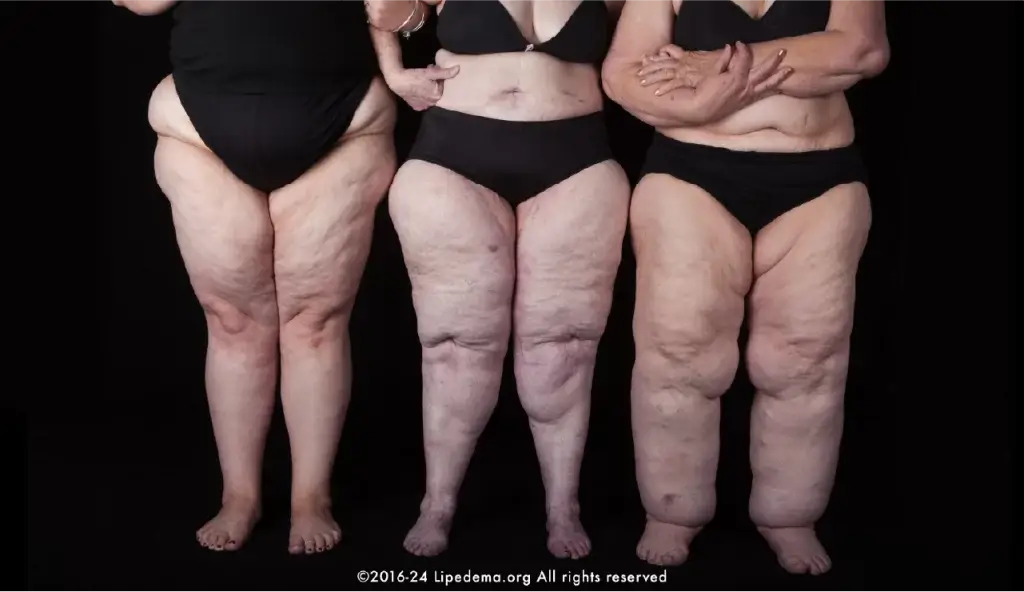
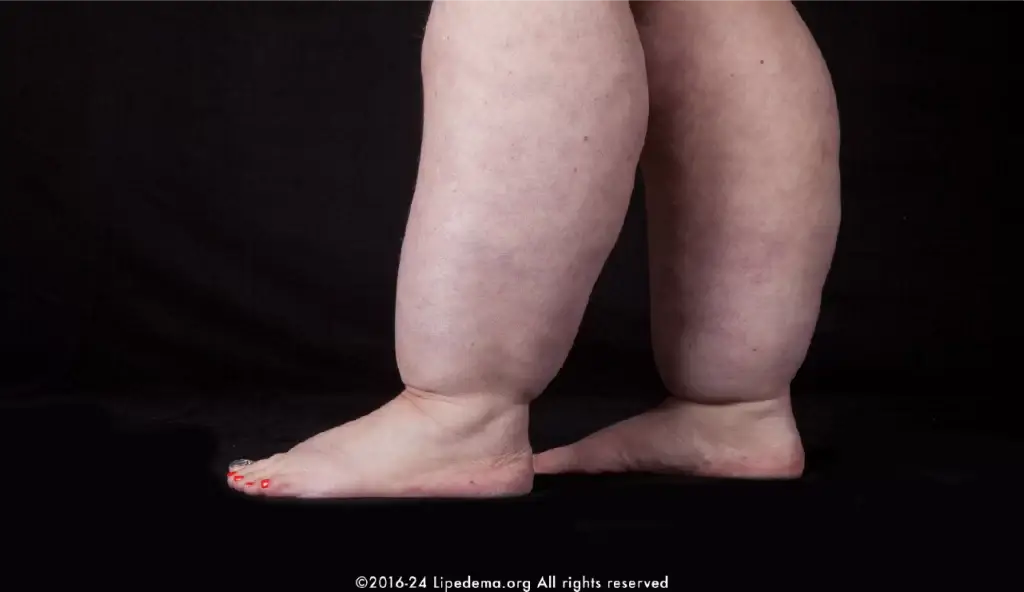
‘Stage’ refers to the advancement of symptoms and progression of the disease. Pain and dysfunction can be present at every stage and body size.
Stage 1: Skin has a smooth texture with a pebble-like feel beneath the skin due to underlying loose connective tissue fibrosis.
Stage 2: Patients have more lipedema tissue than those with Stage 1. Skin is now dimpling (appears like cellulite) due to progressed fibrotic changes and excess tissue. Palpable nodules may be larger and more numerous.
Stage 3: Significantly increased lipedema tissue, more fibrotic in texture, with numerous large nodules beneath the skin. Overhanging lobules of tissue now change the normal anatomy of the affected areas.
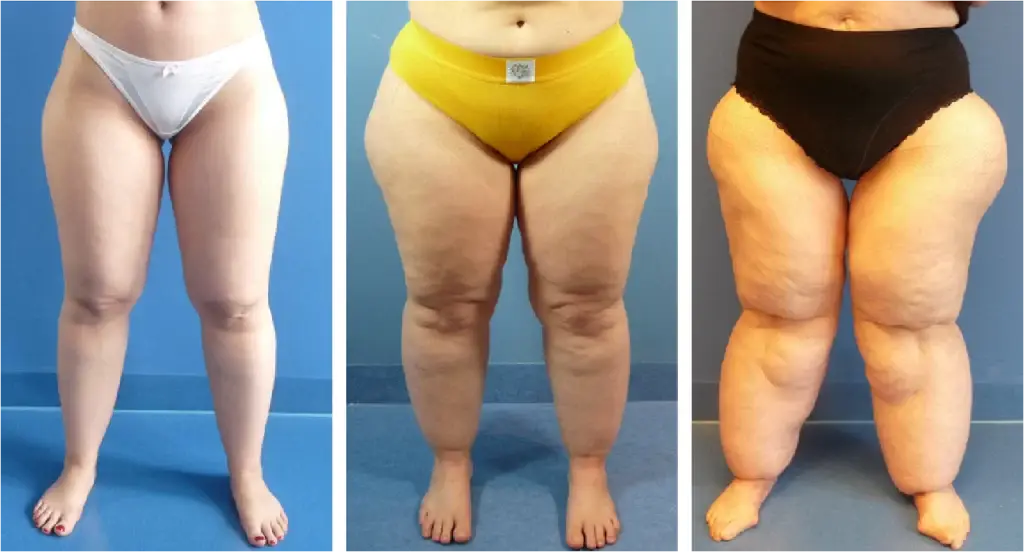
‘Types’ of lipedema refer to the areas of the body affected by lipedema fat accumulation.
Lipedema has five main types and often people with lipedema may have a combination of types. For example: Type III/IV is a person who is affected by lipedema from the pelvis to the ankles as well as the arms. Many persons with lipedema do not fit neatly into just one category.
Type I:
Fat accumulation in the buttocks, pelvis, and hips
Type II:
Fat accumulation from the buttocks to the knees with folds of fat around the knees (medial knee fat pads)
Type III:
Fat accumulates from the pelvis to the ankles
Type IV:
Fat accumulates from the shoulder to the wrist
Type V:
Fat accumulates around the calves

Skin may bruise easily, even with minor trauma.
Affected areas may appear swollen or puffy. The swelling is usually worse after long periods of standing or towards the end of the day. The swelling typically resolves overnight or with elevation of the legs. Lipedema swelling is non-pitting, meaning it does not leave an indentation in the skin when pressed with your fingers.
Lipedema typically affects both sides of the body equally. Unlike conditions like lymphedema, which tends to present asymmetrically (on one side or one limb).
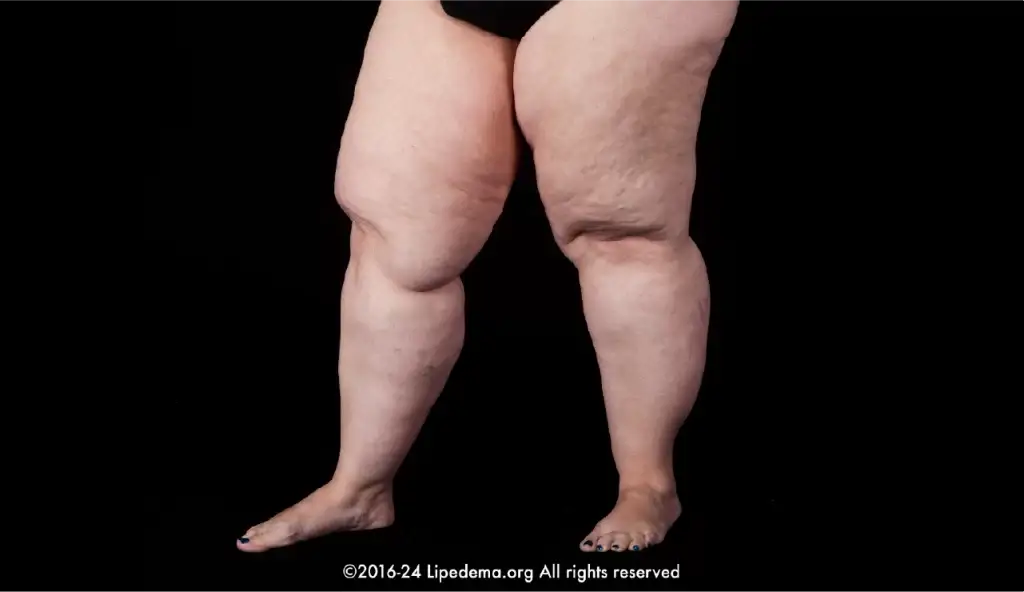
Fat deposits can be tender or painful to the touch. In fact, many patients with lipedema report pain when their blood pressure is checked or when children or pets walk across their lap. Painful fat is a hallmark sign of lipedema. Although the degree of pain and tenderness can vary from person to person and is not stage dependent.
Flexible joints and increased range of motion are common in people with lipedema, and many may have participated in sports like gymnastics, cheerleading, or dance. Hypermobility is also common in those with connective tissue disorders like lipedema or hypermobile Ehlers-Danlos. If you suspect you are hypermobile, it is important to discuss this with your doctor as further testing may be necessary to screen for health risks. Additionally, care should be taken when exercising as a hypermobile body may be more prone to injury.
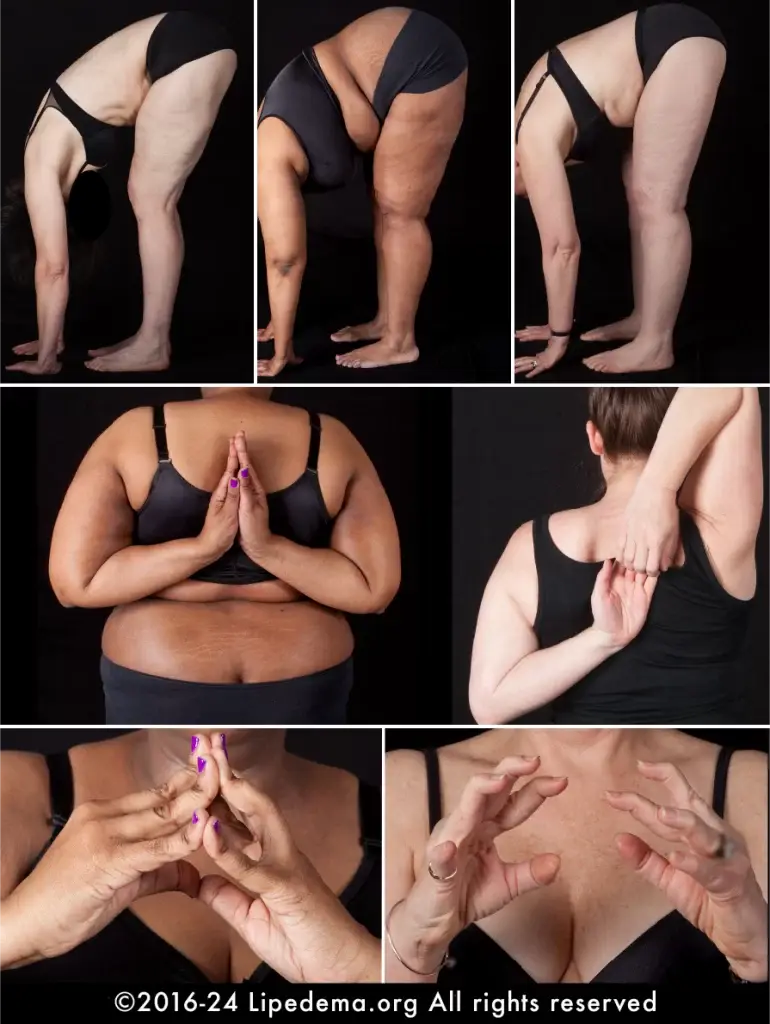
Lipedema can lead to decreased mobility. Walking or long periods of standing are often painful. This can be especially true in the later stages of lipedema.
Although there is currently no cure for lipedema, there are treatments that can help improve a person’s mobility and quality of life.
This often involves Manual Lymphatic Drainage (MLD) performed by a certified massage therapist/physiotherapist with special training in lipedema/lymphedema care. Often referred to as a certified lymphedema therapist.
Sometimes wrapping or bandaging therapy is necessary when there is excess edema (fluid) in the limbs or if a person has lymphedema in addition to lipedema (which can occur in the late stages).
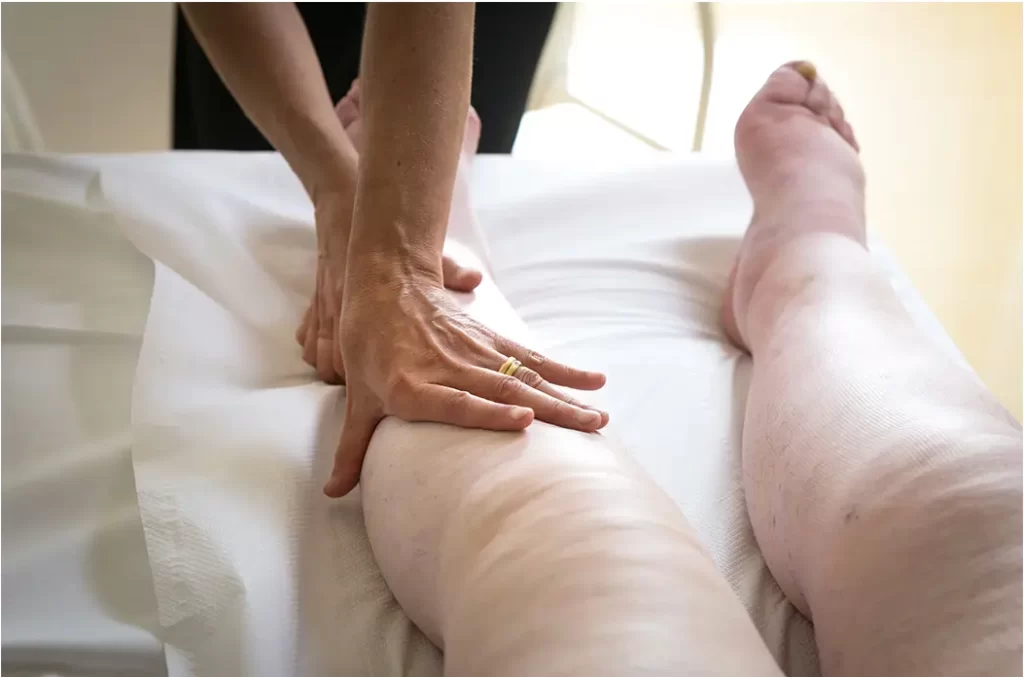
Class II flat-knit made-to-measure medical-grade compression is recommended for lipedema.
Compression can be expensive and is not always covered by provincial or private insurance.
The best compression is the kind you can afford and will wear.
Brands like Czsalus or Bioflect sell compression pants (not flat-knit or medical grade) that can be purchased online for less. It is important to speak to your care provider and a professional garment fitter for personalized compression recommendations to manage your lipedema.

Anti-inflammatory diets (ways of eating) and supplements can be helpful in managing inflammation. Learning which foods contribute to your pain and inflammation can be a good strategy for symptom management.
Stress management is also an important feature of decreasing inflammation in the body.
Practicing good sleep habits, as well as ensuring adequate hydration can also improve your overall inflammatory response.

Weight management helps to reduce strain on the lymphatics and limit disease progression. Support from obesity medicine doctors may be helpful if co-morbid obesity is present.
Lipedema fat is often resistant to diet and exercise interventions. Setting realistic goals around weight management is important for both lipedema patients and their healthcare providers.
Swimming, cycling, and walking are often well tolerated.
People with lipedema may also experience hyper-mobile joints therefore it is important to chose joint safe activities and use caution to not over stretch prior to engaging in exercise.
Be sure to consult a professional before beginning any exercise regime.
Dry brushing, vibration plates, and pneumatic compression devices can be helpful. For more details about these and other self care options check out our patient resources page.
Lipedema can take a toll on those affected. It is important to connect with mental health professionals to get the support you need to manage this chronic illness.
Data suggests treatment with Lipedema Reduction Surgery can provide a significant improvement in pain, sensitivity to pressure, edema, bruising, feeling of tension, and quality of life. Patients also experience significant reductions in the size of extremities and restriction of movement, as well as the need for conservative therapy for lipedema.
Surgeons performing surgery for lipedema should be experienced and trained in the procedure. They should also have a thorough understanding of the condition and its effects on the lymphatic system. Board certification in plastic surgery or a related field is typically required.
Due to a lack of trained, experienced providers in Canada, many patients seek the care of qualified international surgeons.
Navigating Lipedema can be especially challenging in Canada due to the lack of awareness of the condition among healthcare providers.
We aim to continually improve the outlook for those with Lipedema by identifying challenges and seeking solutions to overcome them. We firmly believe that Open Minds – Change Lives.
Lipedema, a condition first described in the 1940s, still poses many research questions. One critical issue is the limited understanding of the disease biology, leading to limited treatment options that merely relieve the symptoms. Thus, further research is necessary to comprehend the biological processes affected in lipedema patients. The absence of diagnostic tools, medical and public unawareness of the disease, and the weight gain stigma contribute to the unknown number of people suffering from lipedema and its epidemiology.
There is hope on the horizon as research on lipedema is in a rapid growth phase. Randomized-control-investigator-blind studies on the effectiveness of Lipedema Reduction Surgery vs conservative measures alone are due at the end of 2024. It is our hope that these studies will help to bring down barriers in accessing care in Canada.
Diagnosis of lipedema is made by physical examination and based on patient and family history.
Finding a clinician who is knowledgeable about lipedema is challenging for several reasons. Lipedema is not currently part of the curriculum in most medical schools in Canada. Many providers are not comfortable making the diagnosis of lipedema. This leaves patients without access to the care and referrals that may be required in order to enjoy the best quality of life.
Depending on your location in Canada, you may find it challenging to find providers for Manual Lymphatic Drainage (MLD or compression fitting. Additionally, regular MLD can cost hundreds of dollars per month. Compression garments are also very costly, sometimes more than $800 per pair.
We are working on a database of providers to aid you in finding the right care near you.
Most provincial healthcare plans currently do not provide coverage for Lipedema Reduction Surgery, although there have been a few exceptions, such as in British Columbia and some highly publicized cases in Manitoba. In Canada, there are no standardized guidelines for methods, litre limits, and a Canadian Standard of Care for lipedema, hence despite some Canadian plastic surgeons offering liposuction to lipedema patients, Lipedema Reduction Surgery is not available in the country. As a result, most patients requiring this surgery need to be referred out of Canada to qualified specialists, which can be very costly and often prohibitive for most people. These surgeries are often multi-stage and can cost between $15,000 to $25,000 per procedure.
Lipedema Canada strongly advocates that medically necessary lipedema surgery should be covered as an insured service by every provincial healthcare plan. Additionally, since many lipedema patients seek the care of international specialists, here are two resources for finding a lipedema surgeon. Please note that neither group nor website is affiliated with Lipedema Canada, and we offer these links as a supplementary resource.
Disclaimer: Lipedema Canada is not a medical provider. This guide is for informational purposes only and is not intended to substitute for professional medical advice, diagnosis, or treatment. Seek the advice of your physician regarding a medical condition or treatment before undertaking any new healthcare regimen.